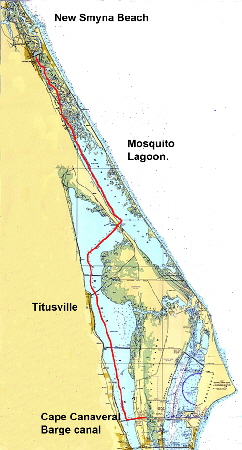Don and Renae Shore had flown from Minnesota to joint us in Florida for a weeks cruise, and learn the gentle art of sailing - or so they thought. It was only going to be a quick jaunt up or down the ICW in Britannia, whichever way the wind blew, with a possible excursion out into the ocean if things went well. It was also a trial run for the boat, to test all the extensive modifications and fittings I had installed over the past year. 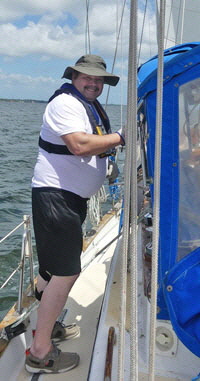 One of these was a complete remodeling of the chart table and transferring and rewiring the whole main electrical distribution panel to another place, and which I had got into a bit of a fix with.
One of these was a complete remodeling of the chart table and transferring and rewiring the whole main electrical distribution panel to another place, and which I had got into a bit of a fix with.
The Shores had never been on a sailboat before, or one that actually moved, and they wanted the experience to see if they liked sailing, with a view of possibly buying a boat themselves.
After they had stowed their gear I showed them how to flush the electric toilets, and be sure not to drop anything down it that they had not eaten first. I showed them how to operate the shower, and words of caution about leaving running water and lights on. Due to their inexperience I insisted they also wear life jackets as they walked about the deck, even though we were tied up in the marina. It is just as easy to trip and fall overboard there, as it is underway. I then started their on deck instruction by refitting the three roller furling sails, the jib, fore staysail and ‘tweenmast staysail. The roller furling mainsail and fore Course squaresail were already snug in their respective tubes. After this I showed them how to coil a rope and heave it ashore, tie a few knots and bend a line to a cleat. All very simple stuff to sailors, but complete mysteries to newbies.
The next day, after filling up with water, the engine was started and I began to back Britannia out of the slip, but after only about ten feet we became stuck on the bottom. We were in th semi-tidal barge canal near Cape Canaveral, Florida, and been there for some time and the combination of over a ton of additional water in the tanks and shifting mud had caused the grounding. I tried to drag her through with the engine, but just caused clouds of black exhaust smoke and mud. Finally I had to call the marina manager to give us a tow with his 150 hp tender. This dragged us over the bank and into deeper water, but not a very auspicious start to our little cruise. That was nothing, as more was to follow.
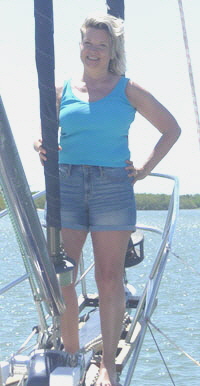 Half a mile down the narrow canal towards the ICW the engine oil pressure gauge dropped to zero, so I immediately cut the engine. My wife jumped behind the wheel as I rushed forward to ready the anchor that was stuck under the adjacent anchor fluke, and I hurt my hand freeing it. As Britannia slowed I let go thirty feet of chain and she swung to a shuddering halt. After patching up my hand I lifted the floorboards and checked the engine oil, which was fine. I suspected electrical trouble and disconnected the oil sender and cleaned the connection then restarted the engine and bingo! 50 lbs of oil pressure. Strange, it never happened then I tested it in the slip…
Half a mile down the narrow canal towards the ICW the engine oil pressure gauge dropped to zero, so I immediately cut the engine. My wife jumped behind the wheel as I rushed forward to ready the anchor that was stuck under the adjacent anchor fluke, and I hurt my hand freeing it. As Britannia slowed I let go thirty feet of chain and she swung to a shuddering halt. After patching up my hand I lifted the floorboards and checked the engine oil, which was fine. I suspected electrical trouble and disconnected the oil sender and cleaned the connection then restarted the engine and bingo! 50 lbs of oil pressure. Strange, it never happened then I tested it in the slip…
We got under way again and I switched on the depth gauge—nothing! Having a working depth gauge is quite important in the shallow intracoastal waterway. It's almost impossible not to run aground with one, but driving blind more of less assures it. I hoped the sender on the outside of the hull had become clogged by dragging her though the mud, and it might clear on its own.
The wind was east to south east 15 knots, so I decided we would go north and I set the jib. It was interesting to see complete novices handling the sheets, (what's a sheet?), through the blocks and trying to wind them round the self tailing winches, often the wrong way. Things we take for granted took some learning by the rooky crew.
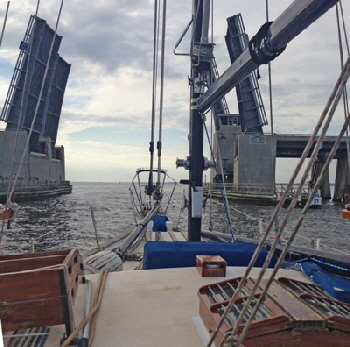 Don unfurled the jib and suddenly found out how much pull there can be on a relatively small sail, and why I had insisted he wear gloves. “That’s how it pulls 22 tons of boat along,” quoth I. Cameras immediately appeared as though we were under full sail at eight knots instead of motor sailing at about three. I say about three knots because the log wasn't working either, was it? The log was a little paddle wheel thing and I supposed it too had become clogged by all the mud kicked up at the start. I hoped it would clear itself but it never worked at all during the whole trip. We had to rely on my wifes I-phone that had an app giving speed over the ground by GPS, and probably more accurate than a spinning wheel anyway.
Don unfurled the jib and suddenly found out how much pull there can be on a relatively small sail, and why I had insisted he wear gloves. “That’s how it pulls 22 tons of boat along,” quoth I. Cameras immediately appeared as though we were under full sail at eight knots instead of motor sailing at about three. I say about three knots because the log wasn't working either, was it? The log was a little paddle wheel thing and I supposed it too had become clogged by all the mud kicked up at the start. I hoped it would clear itself but it never worked at all during the whole trip. We had to rely on my wifes I-phone that had an app giving speed over the ground by GPS, and probably more accurate than a spinning wheel anyway.
We sailed under a fixed bridge then had to roll the jib back in to transit a bascule bridge that opened to my radio request. This delighted our guests who said it was a change to be on the other side instead of waiting in their cars.
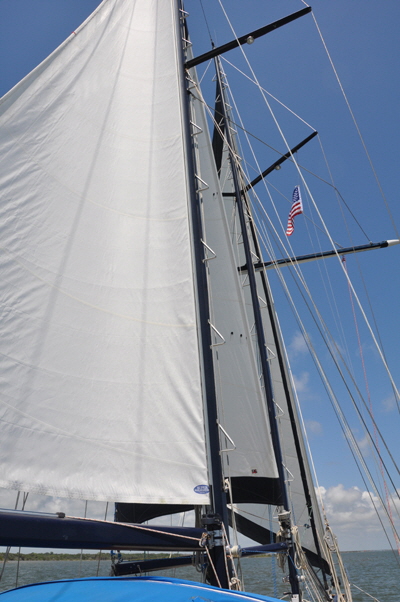 Over a particularly straight stretch I decided to give our guests the feel for real sailing and I pressed the stop button for the engine, but which continued running! It has a solenoid actuated lever to cut the engine, so I had to scramble into the engine again and pull the lever by hand. There were a couple of startled glances as the engine stopped and all went quiet. I have seen this before and it's something about pure sailing that can disconcert landlubbers. How a whopping great boat was moving along without an engine. I have been asked questions like, “How do you stop?” and “What if the engine doesn't start again?”
Over a particularly straight stretch I decided to give our guests the feel for real sailing and I pressed the stop button for the engine, but which continued running! It has a solenoid actuated lever to cut the engine, so I had to scramble into the engine again and pull the lever by hand. There were a couple of startled glances as the engine stopped and all went quiet. I have seen this before and it's something about pure sailing that can disconcert landlubbers. How a whopping great boat was moving along without an engine. I have been asked questions like, “How do you stop?” and “What if the engine doesn't start again?”
Just for good measure I decided to fly our ‘tweenmast staysail, that my crew set about with a little more enthusiasm and knowledge this time. It was a bit more complicated because the Leeward running backstay had to be moved first, but eventually the sail billowed forth, to more camera clicks. This was about all I thought prudent as the wind was picking up, gusting at about 20 knots. Using these roller furling loose footed sails soon convinced Don that they were worth all the loss in sail power he had read about, simply for ease of handling. All Britannia’s sails are roller furled, including the large fore course squaresail half way up the foremast, and all controlled from the safety of the cockpit.
We sailed past NASA’s vehicle assembly building where the space shuttles were built, and within sight of Pad 39b where they were launched. More camera clicks.
We then decided to pick up a buoy for the night in the City of Titusville mooring field. The crew hooked the mooring line successfully and I showed them how to set an anchor bridle, after which we celebrated their first successful “voyage” with champagne. We had sailed the magnificent distance of twenty miles, but our guests thought it was about a hundred.
In the morning we had a leisurely breakfast, slipped the moor and sallied forth in a northerly direction once again. The twisty intracoastal made it impractical to set sails until we passed through the canal into the large Mosquito Lagoon passage that is almost directly north, to New Smyrna Beach. Here I had them pull out the mainsail as well as the jib and ‘tweenmast staysail and we sailed majestically for a couple of hours even though some of the narrower sections with houses both sides of the fairway. People waved and shouted “fabulous boat,” and words to that effect. I felt very proud.
We arrived at New Smyrna Beach just after lunch, still with no gauge to measure depth in the anchorage. I then presented Don with my “lead line,” and led him to the bow as Kati steered very slowly into the anchorage, Don swung the lead and counted the knots disappearing under the surface. When we were in two fathoms I let go fifty feet of chain and let Britannia drift astern. At this point I showed Don how I always anchored for a nights stay. After running out about 50 feet of chain I attached our second anchor to the chain and heaved that over as well. We then ran out another fifty feet to be well and truly moored for the night. I told him it was my practice to never, ever lie to one anchor at night, and my system has never failed.
Even as the sun set it was very hot below decks so I decided to start the generator to run our twin AC units. It fired first time, but then after a few minutes it stopped. I suspected another clog up of mud in the filter or lines so I tried to unscrew the plastic filter bowl on the seacock, that wouldn't move. Don said, “let me have a go,” and put so much leverage on the filter it snapped the 1” inch seacock clean off the through-hull, with an associated gush of water! Don received a face full and a soaking, but he had the presence of mind to press his hand over the hole and partly stop the flow that had already activated the automatic bilge pump. I rummaged though my wooden plugs box and found a suitable size that Don shoved into the through-hull and stopped the influx. A few taps with a hammer to seal the plug and the emergency was over, but it still left me with a dry mouth. Kati put the kettle on, while I wedged a length of wood over the plug to stop it popping out and I never touched it again until we were back in our home marina. It was actually the first time in forty plus years of boating that I have ever used these special tapered wooden plugs, but I didn't tell our guests that. I was just glad to have the plugs handy, “Happens all the time,” says I. I also made a mental note to fasten a plug on every sea-cock when we got back, that would have saved precious minutes trying to find the correct size.
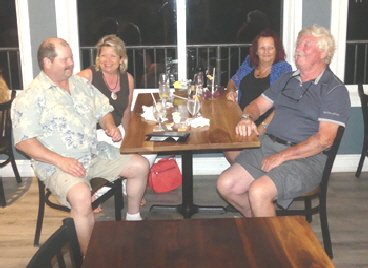 Don has had a wealth of experience with diesel engines, and I was pleased to find he didn't mind getting his hands dirty either. We re-routed the generator inlet pipe to another sea-cock and the genny started again, but then stopped once more. Clearly, it was not only a clogged filter or pipe and we diagnosed a faulty electric fuel pump. I therefore needed to go ashore to find one in a auto supply store somewhere, since I knew the pump was the same as used on car engines.
Don has had a wealth of experience with diesel engines, and I was pleased to find he didn't mind getting his hands dirty either. We re-routed the generator inlet pipe to another sea-cock and the genny started again, but then stopped once more. Clearly, it was not only a clogged filter or pipe and we diagnosed a faulty electric fuel pump. I therefore needed to go ashore to find one in a auto supply store somewhere, since I knew the pump was the same as used on car engines.
There was a lot of dinghy traffic in the anchorage, so I hailed one who looked like he might be heading ashore and he offered me a lift. Not only that, but he ran me to the nearby auto parts store in his car, where I bought a fuel pump for $56. After doing his own shopping my good Samaritan took me back to Britannia, then with a wave continued to his own boat. Our guests were pleased to learn that it was easier to thumb a lift on the water than on land, and boating people tend to help each other very readily.
Don and I installed the new pump and the generator ran continuously after than, enabling the AC to be on until the air cooled for the night. I did get up a couple of times in the night to inspect the sea-cock, but all seemed dry.
With the wind easterly and on shore, blowing 20 to 25 knots and four foot seas outside in the Atlantic, I decided it would be prudent not to venture out through the nearby Ponce inlet, with a wooden plugged boat and guests who had never been to sea before. That really would be tempting Neptune for the plug to vibrate loose, and with two sea-sick passengers who thought they would die. Both of them seemed relieved to hear it. We stayed another day at anchor, enjoying the passing boats and the nautical scene in general, then set off south for home.
The wind had shifted south easterly so we could only set a tight jib as we motor sailed back the way we had come. This time though an horrendous rain storm hit us but that was thankfully short, but it gave our guests an opportunity to test their new foul weather gear. Half way home the engine water temperature gauge failed and I had to throttle back a little for fear of overheating. I concluded we had another electrical fault, but I kept an eye on the motor just in case.
We arrived back at our berth late in the evening and I fully expected to get stuck in the same mud like when we left. As I edged Britannia into her berth she bottomed but a quick burst on our trusty “Perky” pushed her through. I attributed this to having used up a good load of the water we had taken on amounting to a slight reduction in draft. Later the forward toilet refused to flush and I diagnosed a faulty circuit board. My reasoning for buying two electric toilets the same make was now confirmed, because I carried a spare circuit board to both toilets, and soon had it working again.
Don and Renae said they were delighted with their first experience of yachting, notwithstanding that things had not gone so swimmingly. It had given them an insight into all the things that can happen on a complicated cruising boat, and for which they needed to be prepared. They said it had not put them off their dream one bit, to which Kati and I just looked at each other and shrugged. Some people advertise sundown cruises, perhaps we could advertise “breakdown cruises.”
After seeing Don and Renae off to the airport in an Uber we stayed on board for the night Then, unbelievable as it may sound, during the night our aft cabin AC broke down and was later diagnosed as a faulty compressor and burned out relay. Boats, who’d ‘av ‘em?
EPILOGUE
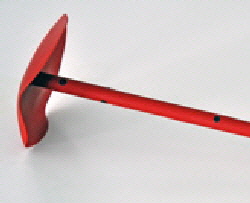 The electrical problems were due to bad connections and grounds on the gauges and senders, that I hasten to add, I never touched in my re-wiring. The engine solenoid just needed oiling after which it has worked flawlessly - so far.
The electrical problems were due to bad connections and grounds on the gauges and senders, that I hasten to add, I never touched in my re-wiring. The engine solenoid just needed oiling after which it has worked flawlessly - so far.
I repaired the broken sea-cock without even lifting the boat, using a nifty British product called a Sea stopper. This is a rubber mushroom shaped device that when inserted down a skin fitting opens out with the pressure of water and seals the through-hull fitting, enabling repairs to be effected. Even so, there is now a wooden tapered plug tied to all seacocks.
I withdrew the log impeller and found it completely clogged with mud and barnacles. I don't really like these little impeller type logs for that reason, but after cleaning it worked fine.
The depth gauge is still not working properly, but this might be due to having only about 12” inches under the keel in our berth.
A replacement spare circuit board for the toilet from Raritan Engineering cost $165
The AC unit was eight years old and not worth trying to repair. I bought a new 16,000 BTU unit for $1850 and installed it. This does not bode well for the forward unit, which is the same age.
After a few years looking at various boats Don and Renae have finally bought a 39’ foot C & C sloop. they were motivated a little by their son moving to Fort Lauderdale, with his job and a new born grandson. Don and Renae found the boat that includes tenure to the liveaboard mooring, so they can live on it whenever they visit. It will be interesting for me to see how they have matured in the boating life, when I next meet them on their own boat.
How a shakedown cruise turned into a breakdown cruise.
